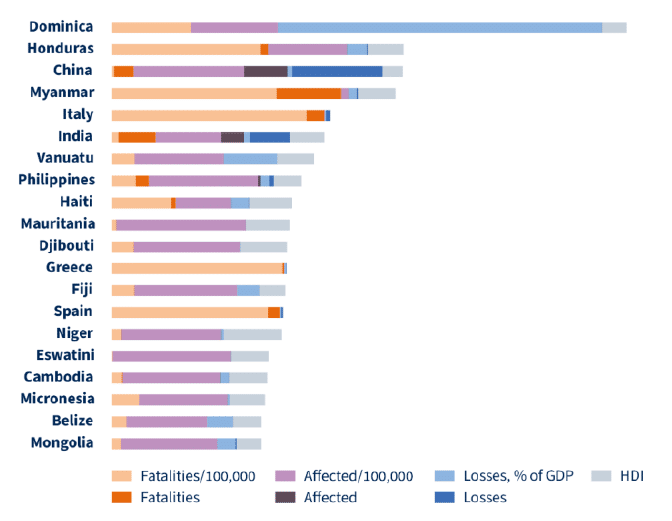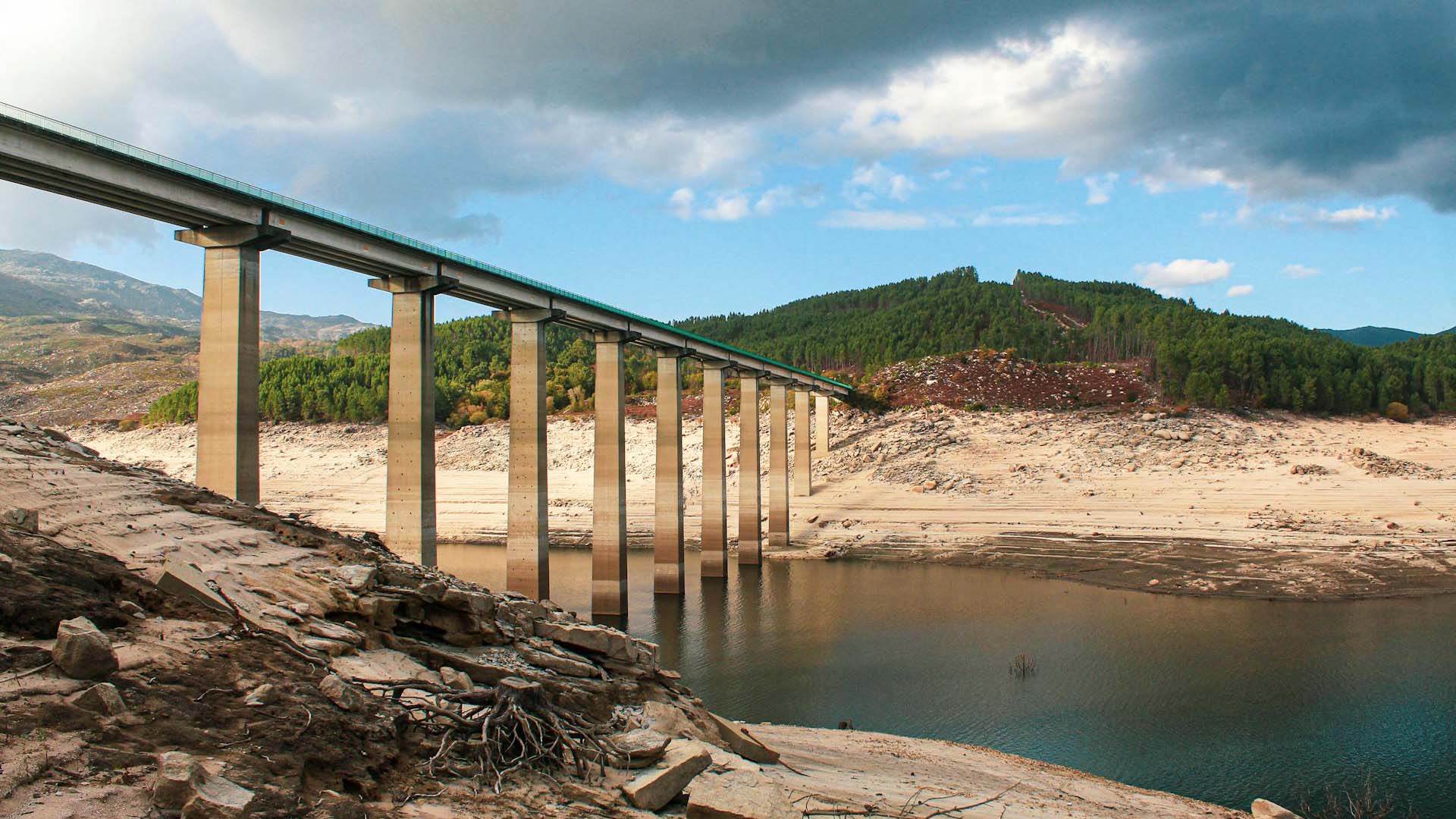Climate change is giving Spain no respite. Last month was the hottest June on record (the temperature hit over 46ºC in the Andalusian village of El Granado) and the last three days of May were among the 10 hottest days for that month. Over the past 30 years Spain has been one of the 20 countries most affected by climate change (see Figure 1).
The average daily high temperature rose from 18.3ºC in 1975 to 20.0ºC in 2021, the last year for figures, and the average low from 7.6ºC to 9.0ºC (…).
Figure 1. The 20 countries most affected by climate change in 1993-2022 (HDI-corrected)

Source: GermanWatch.
Some 20% of mainland Spain is already desertified, due to climate change and overexploitation of water, particularly groundwater extraction, and a further 74% is at risk of desertification. Some coastal areas are extremely vulnerable to rising sea levels. The average daily high temperature rose from 18.3ºC in 1975 to 20.0ºC in 2021, the last year for figures, and the average low from 7.6ºC to 9.0ºC, according to Extreme Weather Watch. These increases are significant.
Furthermore, Madrid is one of the world’s cities that has most suffered from a climate ‘flip’ in the last 20 years, switching quickly from dry to wet extremes and vice versa.[1] In January 2021 the city was one of the worst areas hit by an extratropical cyclone, known as Storm Filomena, that brought the heaviest snowfall in over a century and freezing temperatures for two weeks. So much snow fell in a city not normally associated with this element that I was unable to leave my house until two neighbours managed to dig a pathway.
At the end of October 2024, 227 people were killed in towns near Valencia, Spain’s third largest city, when a year’s worth of rain fell in just 12 hours, triggering flash-flooding. The torrential rain was caused by high-altitude isolated depression (DANA), fed by an overheated Mediterranean, which particularly impacted floodplains. The severity of the storm was linked to climate change.
March 2025 saw an unusually long cold spell in most of Spain and more rain in the first week of the month than during all of a ‘normal’ spring. Three years earlier, there was so little rain in the region of Extremadura, bordering Portugal, during the hottest year on record that the future of the much-loved acorn-fed hamwas in jeopardy because there were not enough acorns, the key element in the pigs’ diet.
These trends are expected to continue, with temperatures in Spain increasing 1.6 times faster than the global average, according to a report published by the Ministry for Ecological Transition and the Demographic Challenge.[2]
Exceptionally hot weather and the resultant drought in some parts of the country, to which Spain is particularly prone, has triggered numerous wildfires: in 2022, 306,133 hectares were burned, three and a half times more than in 2021. Spain has had three prolonged and intense droughts in the last 40 years: 1982-84, 1991-96 and 2005-09; and five intense and short periods: in 1975-76, 1987-88, 2000-01, 2017-18 and 2022. This dramatically changed in 2025 when abundant rain in 2025 pushed up the average level of reservoirs in the first half of the year to more than 70% of their capacity.
Climate change is impacting water management in a country that is one of the most water-stressed industrialised nations in the world (water stress expresses the ratio between total extracted freshwater and naturally renewable water, considering environmental water needs). Some 500 villages were submerged during the Franco regime in order to build 300 reservoirs between 1940 and 1967. A further 33 were built between 1975 and 2008.
Spain emits 0.6% of the world’s greenhouse gases. Its carbon dioxide emissions per person increased from 5.1 tonnes in 1975 to 8.47 tonnes in 2005 but dropped to 4.6 tonnes in 2023, as measures to combat climate change began to take effect and the country became more environmentally conscious (see Figure 2).
Figure 2. Per capita carbon dioxide emissions from fossil fuels and industry, 1975 and 2023, selected countries (1)
| Tonnes per person 1975 | Tonnes per person 2023 | |
|---|---|---|
| US | 20.4 | 14.3 |
| Germany | 12.7 | 7.1 |
| France | 9.2 | 4.1 |
| Italy | 6.2 | 5.3 |
| Spain | 5.1 | 4.6 |
| China | 1.3 | 8.4 |
Source: GermanWatch.
Spain has significantly reduced its greenhouse gas (GhG) emission in the past 15 years, but a further 30% cut will be needed to achieve the government’s ambitious climate objectives. The updated 2023-30 national energy and climate plan raised Spain’s 2030 GhG-emission-reduction target from 49% to 55% via-à-vis the 2005 level. Despite the pace of emission reduction being steady since the mid-2000s, Spain’s emissions were only slightly below 1990 levels in 2023, while those in EU-27 were 36% below.
Much of the reduction in emissions has come from the progress made in renewable energy. In 2024 renewables accounted for a record 56% of net electricity generation, above the EU average of 47.4%, and Spain was the EU leader in the solar energy share (21%, double that in 2021). Coal accounted for an all-time low of 1.1%. As a result of the greatly increased share of renewables in the energy mix, wholesale electricity prices have fallen 40% in recent years, according to the Bank of Spain.
Spain is ranked 19th out of 64 countries and the EU as a whole in the 2025 Climate Change Performance Index (CCPI), which assesses the progress made in terms of emissions, renewable energy and climate policy (see Figure 3). Around 40% of Spain’s Next Generation EU (NGEU) funds are devoted to green investments.
Figure 3. Climate change performance index, 2025 (1)
| Ranking (2) | Score |
|---|---|
| 4. Denmark | 78.37 |
| 5. Netherlands | 69.60 |
| 6. UK | 69.29 |
| 10. India | 67.99 |
| 15. Portugal | 66.59 |
| 16. Germany | 64.91 |
| 17. EU-217 | 63.76 |
| 19. Spain | 61.57 |
| 26. France | 59.18 |
| 43. Italy | 49.81 |
(2) None of the countries achieved positions one to three because no country doing enough to prevent dangerous climate change.
Source: Germanwatch.
Not everyone is happy at the pace of the ecological transition, particularly in what is known as the ‘empty Spain’, rural areas with very low population densities, such as Soria, where giant wind turbines and vast solar panels dominate the skyline. The film Alcarràs about how a solar park uproots and divides a family that has farmed for generations growing peaches in Catalonia was a box office hit in 2022 and won the Berlin International Film Festival’s Golden Bear award, while As Bestas, about a conflict over wind power, won the Goya award in Spain.
As regards adopting electric cars and installing charging points, Spain is something of a laggard. Electric cars (BEV+PHEV) accounted for 11.4% of total new car sales in 2024, below the EU average of 13.6%. The Netherlands, with a population two and a half times less than Spain’s, has four times more charge points (see Figure 4).
Figure 4. Public charge points in 2024
| Public chargers | Per 1,000 inhabitants | |
|---|---|---|
| France | 155,931 | 2.3 |
| Germany | 159,958 | 1.9 |
| Italy | 58,189 | 0.2 |
| Netherlands | 183,000 | 10.0 |
| Spain | 45,213 | 0.9 |
| Sweden | 53,778 | 5.1 |
| EU-27+Iceland, Liechtenstein, Norway, Switzerland & the UK | 1,020,449 | 2.2 |
The exceptionally hot weather is making more and more Spaniards opt to spend their summer holiday in the cooler north rather than in the overcrowded south of Spain. Bookings in the regions of Galicia, Asturias, Cantabria and the Basque Country are well up on last year, though there, too, climate change is making its presence felt.
[1] See https://www.theguardian.com/environment/2025/mar/12/global-weirding-climate-whiplash-hitting-worlds-biggest-cities-study-reveals#:~:text=Dozens%20more%20cities%2C%20including%20Lucknow,towards%20wetter%20or%20drier%20weather.
[2] Available at http://clivar.es/wp-content/uploads/2025/03/Libro_THE_CLIVAR-SPAIN_REPORT_on_the_climate_in_Spain.pdf.



